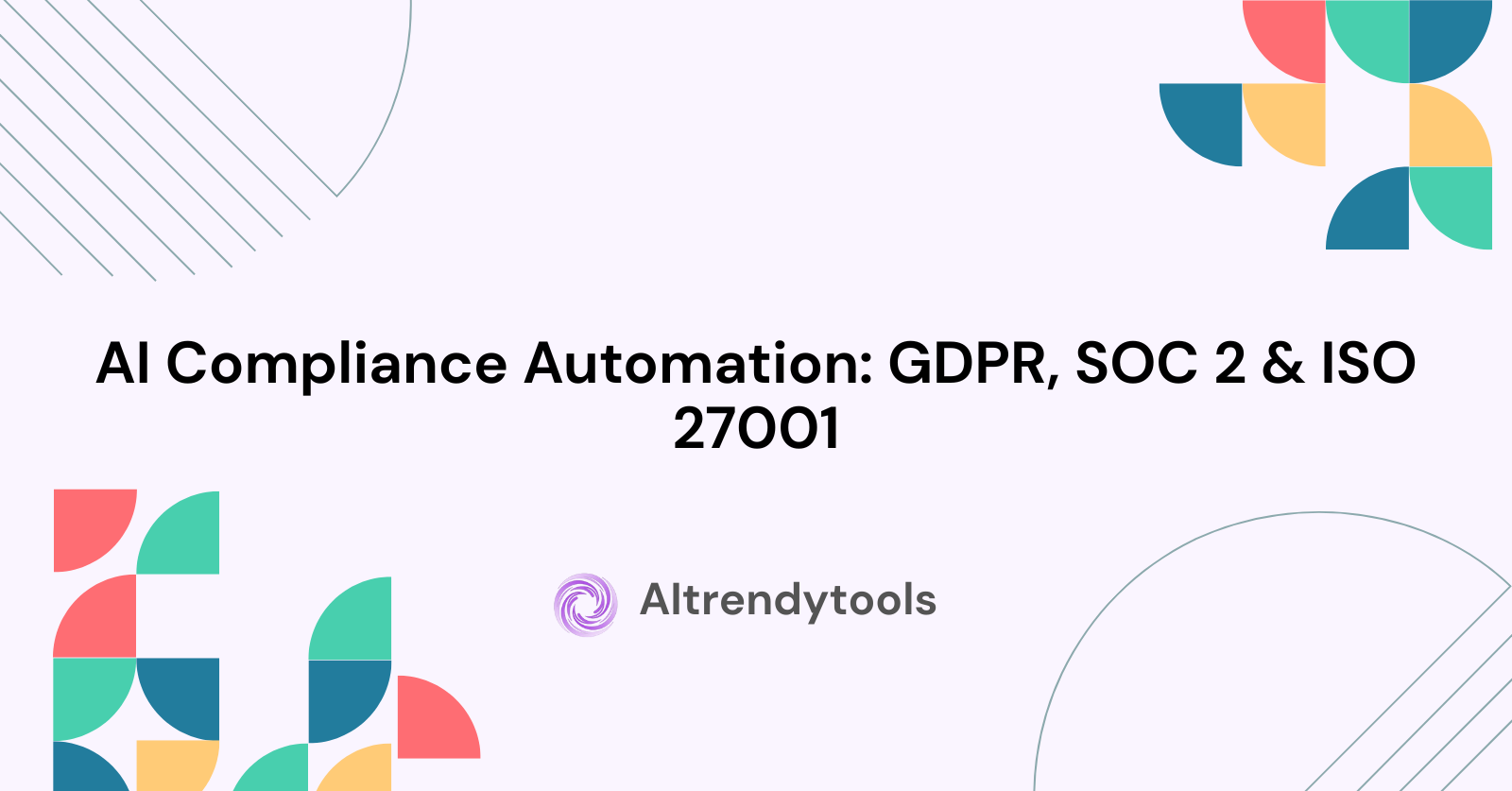🔥 AITrendytools: The Fastest-Growing AI Platform |
Write for usAI Compliance Automation: GDPR, SOC 2 & ISO 27001
Discover how AI automates GDPR, SOC 2, and ISO 27001 compliance. Reduce audit time by 50% with automated evidence collection and real-time monitoring.
Oct 21, 2025
Organizations face mounting pressure to maintain compliance across multiple frameworks while managing day-to-day operations. The regulatory landscape has evolved into a complex web of requirements, creating challenges that traditional manual processes struggle to address. Artificial intelligence offers a transformative solution, automating compliance workflows and reducing the burden on teams. This comprehensive guide explores how AI revolutionizes compliance management, from evidence collection to continuous monitoring.
Understanding Compliance Automation Through AI
Compliance automation represents the intersection of regulatory requirements and intelligent technology. Manual compliance processes consume significant resources, requiring teams to gather evidence, monitor controls, and maintain documentation across various frameworks. AI-driven platforms eliminate repetitive tasks by automatically collecting data from integrated systems.
These platforms connect directly to cloud infrastructure, identity management tools, and security applications. Evidence collection happens continuously rather than at specific intervals. Teams gain visibility into their compliance posture without manually compiling reports or tracking changes across multiple systems.
Key benefits of AI-powered compliance automation include:
- Reduction in audit preparation time by up to 50%
- Real-time visibility into compliance status across all frameworks
- Automated evidence gathering from 100+ integrated systems
- Continuous control monitoring instead of point-in-time assessments
- Decreased reliance on manual spreadsheets and documentation
The shift from reactive to proactive compliance management fundamentally changes how organizations approach regulatory requirements. Modern compliance demands extend beyond annual audits. Organizations must demonstrate continuous adherence to standards while adapting to evolving regulatory landscapes. AI systems monitor controls in real-time, identifying gaps before they escalate into violations.
Automated Evidence Collection Systems
Evidence collection traditionally required manual effort across departments. Staff members gathered logs, screenshots, and documentation individually. This process created bottlenecks during audit periods and increased the risk of missing critical information.
Automated systems pull evidence directly from source applications. Cloud platforms like AWS and Azure integrate seamlessly, providing access logs and configuration data automatically. Identity providers such as Okta contribute user access records without manual exports. The automation extends to task management tools, vulnerability scanners, and monitoring solutions.
The technology maps collected evidence to specific framework requirements. Each piece of documentation aligns with relevant controls across SOC 2, ISO 27001, or GDPR standards. Organizations maintain a centralized repository where auditors access current information without requesting additional materials.
Modern evidence collection platforms offer:
- Native integrations with 100+ cloud services and security tools
- Automated mapping to framework-specific control requirements
- Real-time synchronization ensuring documentation stays current
- Centralized repositories accessible to internal teams and auditors
- Version control tracking changes to security configurations over time
Real-time collection ensures evidence remains current. Changes to infrastructure or policies trigger automatic documentation updates. Teams avoid outdated snapshots that fail to reflect actual security postures. Continuous monitoring creates an accurate compliance record that evolves with organizational changes.
Continuous Controls Monitoring Technology
Point-in-time assessments provide limited insight into ongoing compliance status. Organizations need visibility into control effectiveness between audit cycles. Continuous monitoring transforms compliance from periodic checks into ongoing assurance.
AI platforms perform hourly tests across connected systems. These automated checks verify that security controls function as designed. The technology detects configuration drift, unauthorized access attempts, and policy violations immediately. Alerts notify relevant teams when issues arise, enabling rapid remediation.
Control monitoring extends across entire technology stacks. Network security configurations, endpoint protection status, and data encryption settings receive constant evaluation. The breadth of coverage exceeds what manual processes can achieve. Organizations identify vulnerabilities before they become compliance failures.
Critical monitoring capabilities include:
- Automated testing of 1,200+ security controls every hour
- Configuration drift detection across cloud infrastructure
- Access anomaly identification using behavioral analytics
- Policy violation alerts sent to appropriate team members
- Remediation tracking with automated follow-up workflows
The monitoring generates detailed audit trails automatically. Every check produces documentation showing when tests occurred and what results emerged. This creates accountability and demonstrates due diligence to regulators. The historical record proves continuous attention to compliance requirements.
GDPR Compliance Management Through AI
Data privacy regulations impose strict requirements on organizations handling personal information. GDPR mandates specific protections for EU residents' data, regardless of where companies operate. Compliance involves data mapping, consent management, and breach notification procedures.
AI systems automate data discovery across environments. The technology identifies personal information in databases, file systems, and applications. Classification algorithms categorize data based on sensitivity levels and regulatory requirements. Organizations gain complete visibility into where personal data resides.
Consent management becomes streamlined through automation. Systems track when individuals provide or withdraw consent for data processing. Changes propagate across platforms automatically, ensuring consistent handling of personal information. The technology maintains detailed records of consent transactions for audit purposes.
Essential GDPR automation features:
- Data discovery scanning structured and unstructured data repositories
- Classification engines identifying personal data automatically
- Consent registries tracking opt-ins and withdrawals centrally
- Data subject access request (DSAR) automation locating individual information
- Breach notification workflows meeting 72-hour reporting requirements
Data subject access requests require prompt responses under GDPR. Automated systems locate all information associated with specific individuals across multiple data stores. This reduces response time from weeks to hours. The technology compiles reports that fulfill regulatory obligations while protecting other individuals' privacy.
Privacy impact assessments benefit from AI analysis. Systems evaluate new processing activities against GDPR requirements automatically. They identify potential risks and suggest mitigating controls. This proactive approach prevents privacy violations before they occur.
SOC 2 Framework Automation Benefits
Service organization control reports verify that companies implement appropriate security measures. SOC 2 focuses on five trust service criteria: security, availability, processing integrity, confidentiality, and privacy. Achieving certification requires demonstrating effective controls over extended periods.
AI platforms map organizational processes to SOC 2 requirements automatically. They identify which controls address specific criteria and track implementation status. The technology reduces the learning curve for teams new to compliance frameworks. Pre-configured templates align with auditor expectations, ensuring comprehensive coverage.
User access reviews become efficient through automation. Systems generate reports showing who has access to which resources. They highlight anomalies such as inactive accounts with active permissions or privilege escalations. Automated workflows route review requests to appropriate managers, tracking completion and maintaining audit trails.
SOC 2 automation delivers:
- Pre-built control frameworks aligned with AICPA Trust Service Criteria
- Automated user access review workflows reducing manual effort by 80%
- Vendor risk assessment questionnaires with auto-populated responses
- Security awareness training tracking and completion monitoring
- Customized audit reports formatted for examiner requirements
Vendor risk management integrates into compliance platforms. Organizations assess third-party security postures through automated questionnaires and documentation sharing. The technology monitors vendor certifications and alerts when renewals approach. This ensures supply chain security receives appropriate attention.
Security awareness training requirements receive systematic tracking. Platforms monitor employee completion rates and schedule refresher courses automatically. They generate reports demonstrating organizational commitment to security culture.
ISO 27001 Certification Processes
Information security management systems require formal frameworks under ISO 27001. Organizations implement controls across multiple domains, from access management to incident response. Certification demonstrates systematic approaches to information security.
AI platforms accelerate initial implementation through guided workflows. They present relevant controls based on organizational characteristics and risk profiles. Teams work through requirements systematically without overlooking critical elements. The technology explains each control's purpose and provides implementation examples.
Risk assessment automation identifies threats and vulnerabilities across infrastructures. Systems evaluate likelihood and impact of potential security incidents. They recommend controls based on risk levels, helping organizations prioritize security investments.
ISO 27001 implementation tools provide:
- Guided implementation with step-by-step control deployment
- Risk assessment engines evaluating threats and vulnerabilities
- Policy generation creating customized security documentation
- Gap analysis identifying missing or weak controls
- Internal audit support organizing evidence by standard annexes
The continuous reassessment ensures risk management remains current as threats evolve. Policy generation receives AI assistance. Platforms draft security policies tailored to specific technology stacks and business models. They incorporate industry best practices while allowing customization for organizational needs.
Internal audit preparation benefits from automated documentation. Systems compile evidence demonstrating control effectiveness across all ISO 27001 domains. They organize materials according to standard structure, simplifying auditor reviews. This preparation reduces audit duration and associated costs.
Real-Time Compliance Monitoring Capabilities
Static compliance checks provide insufficient assurance in dynamic environments. Organizations deploy infrastructure changes frequently. Each modification potentially impacts compliance status. Real-time monitoring addresses this reality.
Dashboard displays show current compliance posture across all frameworks. Color-coded indicators highlight areas requiring attention. Teams identify trends in control effectiveness over time. The visualization makes complex compliance data accessible to stakeholders at all levels.
Automated alerting systems notify appropriate personnel when issues emerge. Alerts include context about which controls failed and what remediation steps apply. Teams address problems immediately rather than discovering them during audits.
Real-time monitoring provides:
- Live dashboards displaying compliance status across multiple frameworks
- Instant alerts when controls fail or configurations drift
- Trend analysis showing compliance health over time
- Executive reporting with high-level compliance metrics
- Mobile access enabling remote monitoring and response
Historical reporting capabilities track compliance journeys. Organizations demonstrate continuous improvement in security postures. They show regulators and customers their commitment to maintaining standards over time. The longitudinal data becomes valuable during contract negotiations with enterprise clients.
Integration with incident response workflows ensures compliance considerations factor into security events. When breaches occur, systems automatically document impact on compliance status. They identify notification requirements under various regulations.
Multi-Framework Compliance Strategies
Organizations rarely pursue single compliance certifications. Market demands require SOC 2, ISO 27001, GDPR, and industry-specific frameworks simultaneously. Managing multiple standards creates complexity and redundancy.
AI platforms perform cross-framework control mapping. They identify where single implementations satisfy requirements across multiple standards. For example, encryption controls often address SOC 2, ISO 27001, and GDPR simultaneously. Organizations avoid duplicating effort by implementing controls once and applying them broadly.
Unified dashboards display compliance status across all relevant frameworks. Teams gain comprehensive views without switching between separate systems. This consolidation improves efficiency and reduces the cognitive load of managing multiple standards.
Multi-framework management enables:
- Cross-mapping identifying overlapping control requirements
- Unified evidence serving multiple framework audits simultaneously
- Consolidated dashboards showing all compliance status centrally
- Roadmap planning optimizing certification sequencing
- Resource optimization reducing duplication across frameworks
Evidence collected for one framework serves others automatically. Access logs supporting SOC 2 audits also demonstrate GDPR data processing accountability. The reuse eliminates redundant documentation efforts. Organizations maintain single sources of truth that address multiple regulatory requirements.
Compliance roadmaps guide progression through certifications. Platforms recommend optimal sequences for pursuing frameworks based on existing controls. They identify which additional requirements organizations must satisfy for new certifications.
Vendor Risk Management Integration
Third-party relationships introduce compliance risks. Organizations must verify that vendors maintain appropriate security standards. Manual vendor assessments consume significant resources and often provide limited assurance.
Automated questionnaire systems streamline vendor evaluations. Platforms populate responses using organizational documentation automatically. They request evidence of vendor certifications and review security practices. The technology maintains centralized repositories of vendor assessments for ongoing reference.
Continuous vendor monitoring tracks certificate expiration dates and renewal status. Systems alert procurement teams when vendor certifications require updating. This prevents compliance gaps arising from outdated third-party credentials.
Vendor risk automation includes:
- Automated security questionnaire generation and distribution
- Certificate expiration tracking with proactive renewal alerts
- Risk scoring algorithms evaluating vendor responses
- Contract compliance monitoring throughout relationship lifecycles
- Centralized vendor documentation accessible during audits
Risk scoring algorithms evaluate vendor responses against predetermined criteria. They identify high-risk relationships requiring additional scrutiny. Organizations prioritize limited security resources on vendors presenting greatest threats. The quantitative assessments support informed decision-making about third-party engagements.
Contract management integration ensures compliance requirements appear in vendor agreements. Systems track contractual obligations related to security and privacy. They monitor vendor adherence to terms throughout relationship lifecycles.
Predictive Compliance Analytics
Historical compliance data contains patterns indicating future risks. AI analyzes these patterns to forecast potential issues before they materialize. Predictive analytics transforms compliance from reactive to anticipatory.
Machine learning algorithms identify control failures that precede audit findings. They recognize early warning signs such as increasing exception rates or delayed remediation times. Organizations receive alerts about deteriorating compliance health with sufficient time to intervene.
Trend analysis reveals seasonal patterns in compliance activities. Systems predict peak periods requiring additional resources. Organizations staff appropriately to handle increased audit preparation workloads.
Predictive capabilities deliver:
- Risk forecasting identifying potential failures before occurrence
- Resource planning predicting peak compliance workload periods
- Investment recommendations suggesting where to strengthen controls
- Regulatory change alerts monitoring legislative activities
- Audit readiness scoring evaluating preparedness continuously
Resource allocation recommendations emerge from predictive models. Platforms suggest where organizations should invest in security improvements based on risk profiles. They identify controls requiring reinforcement before weaknesses become violations. This strategic guidance maximizes compliance budgets' effectiveness.
Regulatory change predictions help organizations prepare for evolving requirements. Systems monitor legislative activities and industry trends. They alert compliance teams about potential new regulations affecting their operations.
Implementation Challenges and Solutions
Adopting AI-powered compliance platforms presents challenges despite significant benefits. Organizations must address technical, cultural, and strategic obstacles to successful implementation.
Legacy system integration requires careful planning. Older applications may lack APIs necessary for automated data collection. Organizations need middleware solutions or custom integrations to connect disparate systems. Technical teams must evaluate integration complexity before committing to specific platforms.
Change management becomes critical during compliance automation initiatives. Staff accustomed to manual processes may resist new workflows. Organizations should provide comprehensive training and demonstrate how automation enhances rather than replaces human expertise.
Common implementation challenges:
- Legacy system integration limitations requiring custom development
- Change resistance from teams accustomed to manual processes
- Data quality issues in source systems affecting automation accuracy
- Budget constraints limiting initial platform capabilities
- Vendor selection complexity with numerous competing solutions
Data quality issues affect automated compliance programs. Inaccurate or incomplete information in source systems propagates through automated collection. Organizations must clean existing data and establish governance policies ensuring ongoing accuracy. This foundational work enables reliable automated compliance.
Budget constraints may limit initial platform capabilities. Organizations should prioritize frameworks generating immediate business value. Phased implementations allow spreading costs over time while demonstrating return on investment.
Cost Reduction Through Automation
Compliance expenses traditionally include staff time, consultant fees, and audit costs. Manual processes require significant labor across preparation, documentation, and remediation phases. Automation fundamentally alters this cost structure.
Reduced audit preparation time delivers immediate savings. Teams spend less time gathering evidence and compiling reports. Auditors access necessary documentation through compliance platforms, reducing billable hours. Organizations complete certifications faster, shortening time-to-market for enterprise sales.
Staff reallocation generates additional value. Compliance professionals shift from administrative tasks to strategic security improvements. They focus on risk analysis and control enhancement rather than documentation management.
Financial benefits include:
- 50% reduction in audit preparation time and associated costs
- Staff optimization redirecting resources to strategic initiatives
- Penalty avoidance through continuous compliance monitoring
- Consultant independence reducing reliance on external expertise
- Faster sales cycles enabling enterprise deal closure
Penalty avoidance represents substantial cost savings. Automated monitoring catches violations before regulators issue fines. Organizations maintain compliance continuously rather than scrambling before audits. The risk mitigation prevents costly regulatory enforcement actions and associated remediation.
Consultant engagement decreases as internal capabilities strengthen. Platforms provide guidance reducing dependence on external expertise. Organizations develop institutional knowledge through systematic compliance processes.
Future Trends in AI Compliance
The convergence of AI and compliance continues evolving rapidly. Emerging technologies promise further transformation of regulatory management.
Agentic AI systems will operate with greater autonomy. These platforms will independently execute compliance tasks with minimal human oversight. They will draft policies, assign remediation tasks, and communicate with auditors. Human involvement will focus on strategic decisions rather than operational activities.
Blockchain technology may enhance evidence integrity. Immutable records could prove control implementations occurred at specific times. This technology addresses auditor concerns about documentation tampering.
Emerging trends shaping compliance automation:
- Agentic AI executing compliance workflows autonomously
- Blockchain integration providing immutable audit trails
- Natural language processing interpreting new regulations automatically
- Enhanced predictive analytics forecasting compliance needs
- Deeper operational integration embedding compliance in development
Natural language processing will improve regulatory interpretation. Systems will analyze new regulations automatically, identifying implications for specific organizations. They will translate legal language into actionable technical requirements. This reduces the specialized expertise needed to maintain compliance with evolving regulations.
Predictive capabilities will become more sophisticated. AI will forecast compliance needs based on business growth plans. Systems will recommend framework certifications supporting market expansion strategies.
Making the Move to Automated Compliance
Organizations ready to embrace AI-powered compliance should approach implementation strategically. Success requires planning, stakeholder alignment, and realistic expectations.
Current state assessment identifies pain points in existing compliance processes. Organizations document time spent on various activities and challenges encountered during audits. This baseline measurement enables quantifying improvement after automation implementation.
Framework prioritization determines where to begin automation journeys. Organizations should select certifications generating immediate business value or consuming excessive manual resources. Success with initial frameworks builds confidence for expanding to additional standards.
Implementation roadmap steps:
- Assess current state documenting manual process pain points
- Prioritize frameworks selecting highest-value certifications first
- Evaluate platforms conducting proof-of-concept testing
- Engage stakeholders securing cross-functional buy-in
- Execute phased rollout minimizing disruption while proving value
Platform evaluation includes hands-on testing of leading solutions. Organizations should conduct proof-of-concept projects assessing integration capabilities and user experiences. Technical teams verify that platforms connect to existing infrastructure without extensive custom development.
Stakeholder engagement ensures buy-in across departments. Compliance initiatives affect IT, legal, HR, and operations teams. Early involvement of these groups identifies requirements and addresses concerns proactively.
Phased rollout minimizes disruption while demonstrating value. Organizations begin with single frameworks or business units. They refine processes based on initial experiences before enterprise-wide deployment. This measured approach reduces risks while building organizational capability.
Frequently Asked Questions About AI Compliance Automation
How long does it take to implement AI compliance automation?
Implementation timelines vary based on organizational complexity and framework scope. Most organizations achieve basic automation within 4-6 weeks. Full integration across multiple frameworks typically requires 3-6 months. Phased approaches allow starting with high-priority certifications while gradually expanding coverage.
Can AI compliance tools integrate with existing systems?
Modern platforms offer native integrations with 100+ common business applications including AWS, Azure, Google Workspace, Okta, GitHub, and major security tools. Open APIs enable custom integrations for proprietary or legacy systems. Technical evaluation during vendor selection ensures compatibility with existing infrastructure.
What compliance frameworks does AI automation support?
Leading platforms support major frameworks including SOC 2, ISO 27001, GDPR, HIPAA, PCI DSS, CCPA, NIST CSF, and ISO 27701. Cross-framework mapping identifies overlapping requirements. Organizations manage multiple certifications through unified dashboards without duplicating evidence collection efforts.
How much does AI compliance automation reduce audit costs?
Organizations typically reduce audit preparation time by 50% or more. This translates to lower auditor billable hours and faster certification timelines. Staff optimization redirects resources from administrative tasks to strategic security improvements. Total cost savings including penalty avoidance often exceed platform investment within the first year.
Is automated evidence collection audit-ready?
AI platforms generate audit-ready evidence meeting examiner requirements. Continuous collection ensures documentation remains current rather than relying on outdated snapshots. Automated mapping organizes evidence according to framework structure. Auditors access centralized repositories reducing back-and-forth requests typical of manual processes.
Conclusion: Embracing the Future of Compliance
The transformation of compliance through artificial intelligence represents one of the most significant operational improvements available to modern organizations. Automated platforms eliminate manual burdens while improving accuracy and visibility. Organizations that embrace these technologies position themselves for success in increasingly regulated markets.
The combination of efficiency, risk reduction, and strategic insight makes AI-powered compliance automation essential for competitive advantage. Teams redirect energy from administrative tasks to meaningful security enhancements. Continuous monitoring replaces periodic scrambles before audits. Predictive analytics enable proactive risk management rather than reactive firefighting.
Organizations beginning their automation journeys should start with frameworks generating immediate business value. Phased implementations prove return on investment while building internal capabilities. The technology continues evolving, with emerging innovations promising even greater transformation of compliance management.
The question facing organizations is not whether to adopt AI compliance automation, but how quickly they can implement it to maintain competitive positioning in enterprise markets. Those who delay risk falling behind competitors who leverage automation for faster sales cycles, stronger security postures, and more efficient operations. The future of compliance is automated, intelligent, and strategic rather than manual, reactive, and administrative.
🚀 Submit Your Tool to Our Comprehensive AI Tools Directory
Get your AI tool featured on our complete directory at AITrendytools and reach thousands of potential users. Select the plan that best fits your needs.





Join 30,000+ Co-Founders
Related Blogs
TechMapz Com: 7 Reasons It's Your Best Tech Hub
Discover TechMapz com the ultimate technology hub for gadget reviews, AI trends, cybersecurity tips, and tech news. Explore features that make it stand out in 2025.
Sci Hub: 10+ Free Alternatives to Access Research Papers
Discover Sci Hub alternatives and 10+ legal ways to access research papers free. Complete guide to scientific journals, open access, and academic resources.
Picverse AI Review: Create Stunning Images in Seconds
Discover how Picverse AI transforms text into stunning visuals. Features, pricing, pros & cons everything you need to know about this AI image generator.
Submit Your Tool to Our Comprehensive AI Tools Directory
List your AI tool on AItrendytools and reach a growing audience of AI users and founders. Boost visibility and showcase your innovation in a curated directory of 30,000+ AI apps.





Join 30,000+ Co-Founders

